At the start of the year the museum team received a vague message from a friend of a staff member that Oxfordshire County Council Museum Service was disposing of ‘a physician’s dress’. Disposal is a means by which museums manage their collections to ensure that they can provide the best care possible to objects and that the items they hold are of use to the museum. This is usually determined through assessing the significance of the object to the collection – does it relate to the themes and aims of the museum, does it have potential future use, could it be more relevant or better cared for elsewhere?
Upon further enquiry, we discovered that Oxfordshire Museums were disposing of the court dress of Sir William Withey Gull (1816–1890) because it had no connection to Oxfordshire, and so were offering it to other accredited museums. The court dress would have been worn when Gull attended Queen Victoria’s court, and consists of a black velvet jacket and trousers, a silk waistcoat, a fur hat (possibly made of beaver), a crimson sash and a trunk that the items would originally have been stored in.
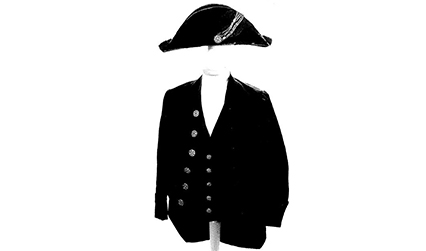
The court dress was an intriguing collection of items and fit in with the RCP Museum’s collecting policy, meaning that we were keen to acquire it. There was one problem however: storage.
‘But where will we keep it?’ is a cry frequently heard in museums when discussing obtaining new items. Space is at a premium, and it can often be a struggle to find room for items, particularly if they are large or heavy. This is complicated by the fact that different materials need to be kept in different conditions. Depending on what an item is made of it may need to be kept in specific environmental conditions, or protected from light, or even protected from itself – for instance the dye in the textile of the court dress can cause the metal buttons to corrode, requiring a barrier layer of tissue to be inserted between the two.
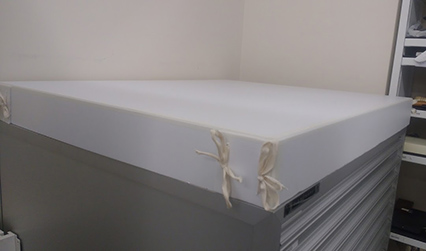
There are a number of ways to store museum textiles safely. One is to roll them, which was not suitable in this case as clothing items are not flat. Another is to hang them from padded hangers and then protect them with dust covers. This works well for costume, but was not an option for us as it would have required losing a whole bay of storage that is full of other objects. That left a third option: using large boxes and padding out the folds of the garments with acid-free tissue to prevent creases.
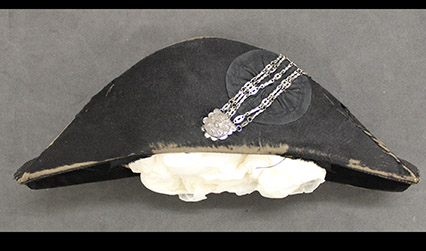
The problem about storing objects in boxes is that you also need somewhere to keep the boxes. The only space big enough in our store, the area on top of our planchest for large-sized prints and photographs, was already taken up with two dishes that were themselves too large to live elsewhere. Acquiring the Gull costume was going to need some clever storage solutions.
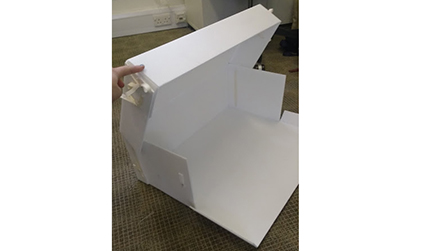
Having worked out that the jacket, trousers, waistcoat and sash could be stored in three pre-bought boxes, the next stage was to create a way for the boxes and the dishes to sit on the planchest. This was done by building a solid cover over the two dishes. A lid was made out of correx (a type of corrugated plastic), supports were added so that it could take the weight of the other boxes sitting on top of it, and the lid was then sat on the top of the planchest, covering the dishes.
That just left the storage of the hat.

Gull’s hat is a cocked or bicorn hat meaning that, although it is possible to purchase pre-made museum quality hat boxes, this one is larger than any of the boxes available, and so a custom made box had to be constructed. I used the dimensions provided by Oxfordshire Museums to draw a net from which to make the box, cut this out (making sure to only cut and score the correct parts), folded it, and then used cotton tape and Velcro to secure the sides together.
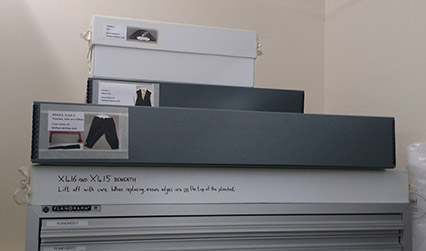
With the storage prepared, the next thing was to collect the items. This required a trip to Oxfordshire Country Council Museum Resource Centre to pack the court dress into the various boxes ready for transportation. Acid-free tissue paper was used to pad out the boxes to prevent the garments moving and the trunk was wrapped carefully with tissue, foam and bubble wrap to avoid any knocks and scrapes. They were then officially signed over by Oxfordshire Museums to the RCP and transported back to the RCP Museum, where they were formally entered into the collection, catalogued and re-packed for storage.
Lowri Jones, collections officer
Read more about William Withey Gull's life and work in our blog post ‘Fools and savages explain: wise men investigate'.
